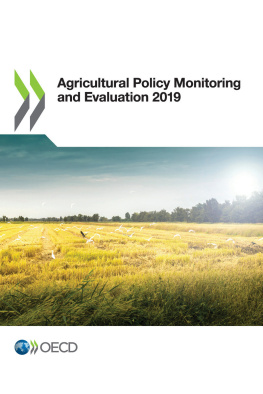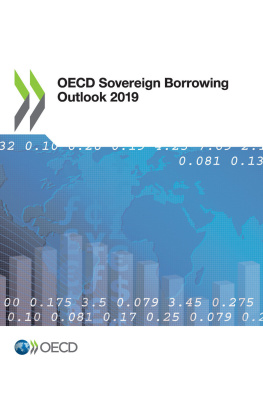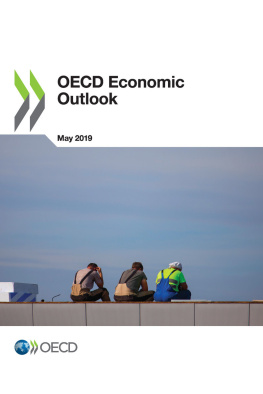OECD - OECD Economic Outlook, Volume 2019 Issue 2
Here you can read online OECD - OECD Economic Outlook, Volume 2019 Issue 2 full text of the book (entire story) in english for free. Download pdf and epub, get meaning, cover and reviews about this ebook. year: 2019, publisher: OECD Publishing, genre: Politics. Description of the work, (preface) as well as reviews are available. Best literature library LitArk.com created for fans of good reading and offers a wide selection of genres:
Romance novel
Science fiction
Adventure
Detective
Science
History
Home and family
Prose
Art
Politics
Computer
Non-fiction
Religion
Business
Children
Humor
Choose a favorite category and find really read worthwhile books. Enjoy immersion in the world of imagination, feel the emotions of the characters or learn something new for yourself, make an fascinating discovery.
OECD Economic Outlook, Volume 2019 Issue 2: summary, description and annotation
We offer to read an annotation, description, summary or preface (depends on what the author of the book "OECD Economic Outlook, Volume 2019 Issue 2" wrote himself). If you haven't found the necessary information about the book — write in the comments, we will try to find it.
OECD: author's other books
Who wrote OECD Economic Outlook, Volume 2019 Issue 2? Find out the surname, the name of the author of the book and a list of all author's works by series.
OECD Economic Outlook, Volume 2019 Issue 2 — read online for free the complete book (whole text) full work
Below is the text of the book, divided by pages. System saving the place of the last page read, allows you to conveniently read the book "OECD Economic Outlook, Volume 2019 Issue 2" online for free, without having to search again every time where you left off. Put a bookmark, and you can go to the page where you finished reading at any time.
Font size:
Interval:
Bookmark:

OECD (2019), OECD Economic Outlook, Volume 2019 Issue 2 , No. 106, OECD Publishing, Paris, https://doi.org/10.1787/9b89401b-en .
The information in this document with reference to Cyprus relates to the southern part of the Island. There is no single authority representing both Turkish and Greek Cypriot people on the Island. Turkey recognises the Turkish Republic of Northern Cyprus (TRNC). Until a lasting and equitable solution is found within the context of the United Nations, Turkey shall preserve its position concerning the Cyprus issue.
The Republic of Cyprus is recognised by all members of the United Nations with the exception of Turkey. The information in this document relates to the area under the effective control of the Government of the Republic of Cyprus.
For the past two years, global growth outcomes and prospects have steadily deteriorated, amidst persistent policy uncertainty and weak trade and investment flows. We now estimate global GDP growth to have been 2.9% this year and project it to remain around 3% for 2020-21, down from the 3.5% rate projected a year ago and the weakest since the global financial crisis. Short-term country prospects vary with the importance of trade for each economy though. GDP growth in the United States is expected to slow to 2% by 2021, while growth in Japan and the euro area is expected to be around 0.7 and 1.2% respectively. Chinas growth will continue to edge down, to around 5.5% by 2021. Other emerging-market economies are expected to recover only modestly, amidst imbalances in many of them. Overall, growth rates are below potential.
The mix between monetary and fiscal policies is unbalanced. Central banks have been easing decisively and timely, partly offsetting the negative impacts of trade tensions and helping to prevent a further rapid worsening of the economic outlook. Thereby, they have also paved the way for structural reforms and bold public investment to raise long-term growth, such as spending on infrastructure to support digitalisation and climate change. However, to date, other than a few countries, fiscal policy has been only marginally supportive, and not especially of investment, while asset prices have been buoyant.
The biggest concern, however, is that the deterioration of the outlook continues unabated, reflecting unaddressed structural changes more than any cyclical shock. Climate change and digitalisation are ongoing structural changes for our economies. In addition, trade and geopolitics are moving away from the multilateral order of the 1990s. It would be a policy mistake to consider these shifts as temporary factors that can be addressed with monetary or fiscal policy: they are structural. In the absence of clear policy directions on these four topics, uncertainty will continue to loom high, damaging growth prospects.
The lack of policy direction to address climate change issues weighs down investment. The number of extreme weather events is on the rise and insufficient policy action could increase their frequency. They may lead to significant disruptions to economic activity in the short term, and long-lasting damage to capital and land, as well as to disorderly migration flows. Adaptation plans are in their infancy, while mitigation, moving away from fossil fuels, through measures such as carbon taxes, has proved technically and politically challenging. Governments must act quickly: without a clear sense of direction on carbon prices, standards and regulation, and without the necessary public investment, businesses will put off investment decisions, with dire consequences for growth and employment.
Digitalisation is transforming finance, business models and value chains, through three main channels: investment, skills and trade. So far, only a small fraction of businesses appear to have successfully harnessed the strong productivity potential of digital technologies, which partly explains why digitalisation has been unable to offset other headwinds on aggregate productivity. Reaping the full benefits of digital technologies requires complementary investments in computer software and databases, R&D, management skills and training, which remains a challenge for too many firms. Digitalisation is also affecting people and work, because it confers a huge advantage to people whose main tasks require cognitive and creative skills, and penalises those whose work has a large routine element, and at the same time generates new forms of contractual arrangements that escape traditional social protection. But the policy environment to harness new technology concerning skill upgrading, social protection, access to communication infrastructure, digital platform development, competition in digital markets and regulation of cross-border data flows lags behind, making it difficult to reap the benefits of digitalisation in full.
The Chinese economy is structurally changing, rebalancing away from exports and manufacturing towards more consumption and services. Increasing self-sufficiency in core inputs for certain manufacturing sectors is reflecting a desire to move away from importing technology towards national production. A shift in energy utilisation to address pollution, and the rise in services also induce additional changes in Chinese demand for imports. Chinas traditional contribution to global trade growth is set to slow and change in nature. While India is set to grow rapidly, its growth model is different and its contribution to global trade growth will not be enough to substitute for China as a global engine for traditional manufacturing.
Trade and investment are also structurally changing, with digitalisation and the rise of services, but also with geopolitical risks. The rise in trade restrictions is nothing new. About 1500 new trade restrictions have been implemented by G20 economies since the global financial crisis in 2008. Yet, the past two years have seen a surge in trade-restricting measures and an erosion of the rules-based global trading system, which is deep-rooted. Coupled with rising government support across a range of sectors, this induces disruptions in supply chains and reallocations of activities across countries that both exert a drag on current demand by reducing incentives to invest and undermine medium-term growth.
Font size:
Interval:
Bookmark:
Similar books «OECD Economic Outlook, Volume 2019 Issue 2»
Look at similar books to OECD Economic Outlook, Volume 2019 Issue 2. We have selected literature similar in name and meaning in the hope of providing readers with more options to find new, interesting, not yet read works.
Discussion, reviews of the book OECD Economic Outlook, Volume 2019 Issue 2 and just readers' own opinions. Leave your comments, write what you think about the work, its meaning or the main characters. Specify what exactly you liked and what you didn't like, and why you think so.

















